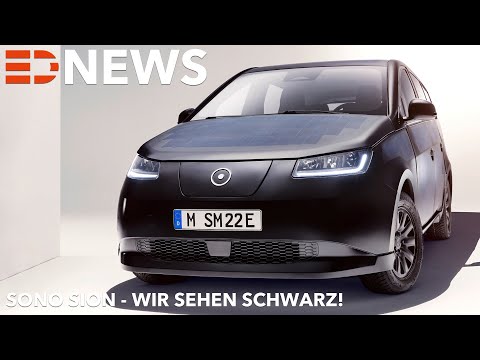2022 SONO SION - we see black! Specifications Dimensions Price Performance
The idea behind the concept of the environmentally friendly and sustainable electric car Sono Sion is to develop a vehicle that emits as few pollutants into the environment as possible. By using renewable energies such as solar and wind energy, the Sono Sion is said to be 100% emission-free. In contrast to conventional electric cars, the Sono Sion also has solar technology, which is intended to provide additional range, and the vehicle can also be used as a power storage device that can even charge the battery itself when stationary - unless you are parked in the shade. The concept of the Sono Sion envisages that the car can be charged at any conventional socket. The charging capacities are 11 kW AC via Type 2 and 75 kW DC via CCS. The charging process takes 12.5 hours at a normal socket and approx. 4-5 hours and at the fast charging station approx. 35 minutes to 80% state of charge, or just under an hour for a full charge. The Sion has an operating voltage of 400 volts. The battery is based on lithium iron phosphate battery technology. The LFP cells consist of iron phosphate on the positive electrode instead of cobalt oxide. This avoided the use of heavy metals such as cobalt and manganese. The elongated cells are arranged transversely to the battery housing and together form a compact battery pack. The battery itself has a capacity of 54 kilowatt hours and should ensure a range of 305 kilometers. However, the solar panels enable the Sion to generate additional range. Light is converted into electrical energy. How it works is quickly explained! Solar cells consist of a semiconducting material that can absorb photons. When a photon is absorbed by a solar cell, it is converted into two electrons. These electrons are free to move and can flow through an external circuit. In short: Light turns into electrical energy, which can then a) be stored and b) be used for locomotion or, with the Sono Sion, can increase the range. The manufacturer speaks of 112-245 kilometers per week and emphasizes another benefit: The charging technology works bidirectionally, i.e. you can use the vehicle as a power storage device and supply other electrical consumers with power. With an output of up to 11 kW, you could even charge other electric vehicles, A peak output of up to 3.7 kW is available via the normal Schuko socket. What drives the Sono Sion? The 3-phase synchronous motor has a peak output of 120 kW, the equivalent of 163 horsepower accelerate the Sion up to a top speed of 140 km/h. For the sprint from 0 to 100 km/h, the vehicle needs about 9 seconds, the power consumption is given as about 16 kWh/100 km. The front axle is always driven on this vehicle. The Sion rolls off the assembly line ex works on 205/60 R16" wheels. The 120 kW electric motor has a torque of 270 Nm and the ability to recuperate with a maximum of 50 kW. The vehicle is 4.47 meters long, including Exterior mirrors are 2.08 meters wide and 1.66 meters high, with a turning circle of less than 11 meters. The wheelbase is 2.83 meters, the ground clearance is 16.5 cm and the trunk volume is not bad either. 650-1,250 liters are available, but the measurements were not based on the VDA standard. The maximum payload is given as around 450 kilograms, so the Sion can put a maximum of 2.18 tons on the road, because it weighs around 1,730 kilograms when empty and ready to drive. A trailer hitch is also provided for the Sono Sion. What's the current status and what's next? Sono Motors is currently manufacturing a fleet of series validation vehicles in Munich near the company headquarters for the Sion test program that has already started. In the coming months, this vehicle generation will be subjected to practical tests under extreme conditions in both Europe and the USA. This includes series validation, homologation,
People In This Video
No users are tagged in this video
Tags
No tags available yet








